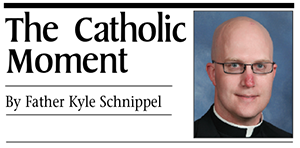Putting our true face forward
 I have a bit of a reputation for being a ‘social media’ priest. I post on Twitter (@FatherSchnippel) fairly frequently, and lurk through the pages of Facebook on a regular basis as well. (Confession: I still do not get Instagram.)
I have a bit of a reputation for being a ‘social media’ priest. I post on Twitter (@FatherSchnippel) fairly frequently, and lurk through the pages of Facebook on a regular basis as well. (Confession: I still do not get Instagram.)
Recently on Twitter, I saw this tweet from Christina Mead who works for Life Teen: “@LT_Christina: Be compassionate because people wear a lot of masks.”
This is one of the reasons I love Twitter. It was such a simple sentiment, but such depth of thought was contained within just the 140 characters of space that Twitter lets you use.
In my work with teens and young people, so often they put forward the face that they want me (or any adult, really) to see, or what is often considered their best face.
It makes me wonder why we do such a thing, and I am quite confident that it is not just teens that do this. We put our best face forward, which is really a mask and a shadow of our true face, when in reality, if we just put our true face forward, that is the more authentic person, the person God created us to be, the the face that God sees when He looks to us…. Yet, we are scared, frightened, immobilized from sharing.
Ultimately, I think it derives down to fear — fear of rejection, for if I show my true face, no one will like me. Fear of not being liked enough to be accepted. Fear of failure. Fear of not measuring up to the standards others set for you.
These fears, however, are often what holds us back and imprison us to the exact thing we fear! O Irony of Ironies!
Instead, turning to the Gospel, how does Jesus really, actually, look at us? So often, when I look at Him looking at me, what I see is that He is looking at my faults and failings, my weaknesses, my sins, my fears, etc. But is this how He really looks at me?
When He looks at the woman caught in adultery in John 8, He sees her, while everyone else only sees her sins. When He looks to Peter in John 21, He sees the love that underlies the weakness that led to the denials during His Passion. When He looks to Saul in Acts 9, He does not see the murderous threats against the church, but the passion and zeal that drives him to Damascus.
If Jesus can look past all these sins, certainly he can look past ours as well. For when He looks at me, at you, He sees first and foremost the potential that He himself gave. He sees those unique talents that He gave solely to you.
When we operate out of this approach, instead of those fears, we are able to find the freedom that He alone can provide. It also gives us that confidence that brought about the healing in the woman, as well as honed the passion and zeal of both Peter and Paul to proclaim the Gospel to the nations.
How do we develop this trust? I think it is as simple as love for Jesus simply asks Peter: “Do you love me more than these?” We must try to echo Peter’s answer, “Yes, Lord, you know that I love you!”
Might these words permeate the entire self so that each one of us can fulfill that definite purpose that God has planned for us and that we all can continue to give a generous “yes” to the Lord.
++++++++
Father Schnippel is the archdiocesan vocation director.













